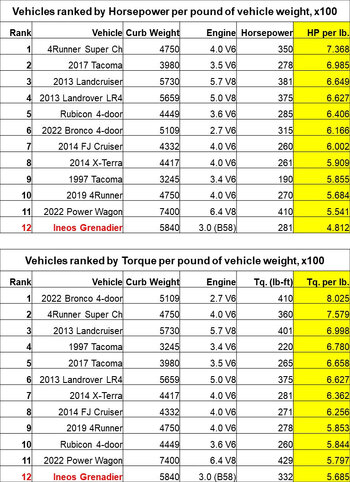- Local time
- 1:02 PM
- Joined
- Nov 14, 2021
- Messages
- 1,176
As a follow-up, the Grenadier is quite heavy (gas version is 5,840 pounds), and is not overly powerful. In fact, for its weight, its power lags behind most of the competition. Below is a table of (1) horse power to weight, and (2) torque to weight of what will look like a random assortment of vehicles (these are vehicles I have either owned or considered buying). The Grenadier comes last in each list. I'm not trying to slag the Grenadier, rather, I am making a point with regard to 35-inch tires: the taller heavier tires will rob the Grenadier of power, and most people who use the Grenadier for highway driving as well as off-road driving will want to re-gear. Before I purchased a Grenadier - if I was dead-set on 35-inch tires - I would want to know two things:
1. Are there after-market gear sets for the Carraro axles?
2. Are they available in the appropriate size? I would guess that one would want to re-gear to something between 4.30 and 4.88.
Related Example: In a Jeep Wrangler, a common choice after moving to 35-inch tires, with the 3.6 Pentastar (NA V6), is 4.56 gears (in Dana axles). The Rubicon version of the Wrangler comes from the factory on 33-inch tires with 4.10 gears. If one opts for the "Recon" off-road package with 35-inch tires, one is given the choice by Jeep of either 4.56 or 4.88 gears (the lower option - 4.88 - provides better towing performance, better grunt off the line, and better throttle response at elevation, but worse fuel-economy). The Grenadier (in both gas and diesel) has much better low-end torque than the 3.6 Pentastar, so one might be okay running 35s with 4.30 gears; on the other hand, the Grenadier is 1,400 pounds heavier than a Wrangler, so maybe 4.56 is the sweet-spot.

1. Are there after-market gear sets for the Carraro axles?
2. Are they available in the appropriate size? I would guess that one would want to re-gear to something between 4.30 and 4.88.
Related Example: In a Jeep Wrangler, a common choice after moving to 35-inch tires, with the 3.6 Pentastar (NA V6), is 4.56 gears (in Dana axles). The Rubicon version of the Wrangler comes from the factory on 33-inch tires with 4.10 gears. If one opts for the "Recon" off-road package with 35-inch tires, one is given the choice by Jeep of either 4.56 or 4.88 gears (the lower option - 4.88 - provides better towing performance, better grunt off the line, and better throttle response at elevation, but worse fuel-economy). The Grenadier (in both gas and diesel) has much better low-end torque than the 3.6 Pentastar, so one might be okay running 35s with 4.30 gears; on the other hand, the Grenadier is 1,400 pounds heavier than a Wrangler, so maybe 4.56 is the sweet-spot.





